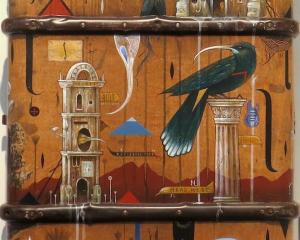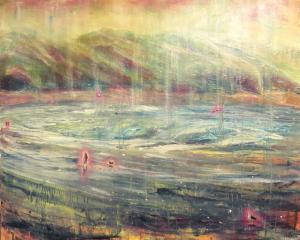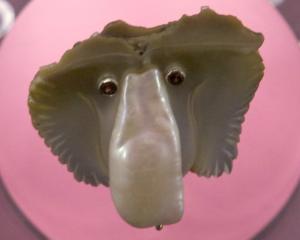In this week's Art Seen, Robyn Maree Pickens looks at works from Barry Cleavin, a collaboration between Xin Cheng and Chris Berthelsen, and the University of Otago's Special Collections.

Barry Cleavin is New Zealand's foremost printmaker, as a visit to the Brett McDowell Gallery will easily confirm. Cleavin's technical mastery is evident in four earlier works (etching, aquatint) from 1998, and a suite of 36 limited edition digital prints from 2015.
Cleavin's digital works begin with a sketch from ''real life'', or occasionally from a photo. The drawings are then imported into Photoshop, and extensively manipulated to produce a variety of effects, including, paradoxically, a resemblance to the hand-made or hand-painted.
In fact, Cleavin's digital manipulations seem to revel in ''de-machining'' the machine, in the subversion of the medium itself. He turns a pixel into a hue.
''36 Views of Hereweka'' is best understood as homage: not just to Hokusai and Hiroshige, the Japanese woodblock masters of the ukiyo-e (pictures of the floating world) style, but to Fujisan (Mt Fuji) the sacred mountain, and of course to Hereweka, or Harbour Cone, near Portobello.
Homage to Hereweka is in turn, an acknowledgement of Ngai Tahu and Ngati Mamoe relations to Hereweka, and of Cleavin's own childhood spent down the bay.
Hereweka in this respect acts as an anchor and daily presence for an artist who has returned home to the city of his birth.

Not many exhibitions invite visitors to make art from materials that they find around them in the gallery space, or to bring in objects they have made for exhibition. But ''Small Modifications'' at the Dunedin Public Art Gallery does just that.
The artists behind the project are Auckland collaborators Xin Cheng and Chris Berthelsen, who, with curator Andrea Bell and the Dunedin Public Art Gallery, have created a welcoming space that encourages play and experimentation with a variety of discarded packaging and other materials.
In addition to an array of whimsical objects made from repurposed pipes, palettes and other materials, there are curious structures that resemble a child's cardboard utopia, or approximate the precarity of provisional, makeshift accommodation found in many cities around the world.
It is this ''everyday resourcefulness'' and ''improvised making'' that Cheng and Berthelsen are interested in exploring in the gallery setting.
Cheng describes ''Small Modifications'' as a ''porous space'' where people can make ''serendipitous encounters'' with ideas, objects and community.
As an ever-evolving process of making and remaking, ''Small Modifications'' is an open studio project that encourages thoughtfulness around the intersections of waste, repurposing and creativity.

Consisting of thousands of volumes of rare and historical books, the University of Otago's Special Collections are nationally and internationally significant.
In addition to acting as kaitiaki of such treasures, the University of Otago Library runs the Otakou Press, a notable Printer in Residence programme and the de Beer Gallery.
Currently on display in the gallery is an exhibition that hones in on the type of research that takes place in Special Collections, and the ways in which this research enriches scholarly projects.
Curator and Special Collections librarian Donald Kerr approached readers from diverse academic fields who have utilised Special Collections, asking each to identify a favourite work.
There are many exquisite items in cabinets and vitrines, such as elaborately illustrated 18th-century volumes on horticulture, the natural world and anatomy, but perhaps the most captivating work is the Hereford Mappa Mundi.
This medieval map represents the northern temperate hemisphere as a circle divided into three areas by a T shape surrounded by ocean.
At the heart of the map is Jerusalem and at the apex lies the Garden of Eden. It is a favourite of Dr Simone Marshall from the English department at Otago, and is a fascinating insight into the medieval mind.
-By Robyn Maree Pickens




![... we all become all of these things [installation view] (2025), by Megan Brady.](https://www.odt.co.nz/sites/default/files/styles/odt_landscape_small_related_stories/public/story/2025/03/1_we_all_become_all_of_thes.jpg?itok=nicA_yAm)


![Poipoia te Kākano [installation view]. Allison Beck, Megan Brady, Kate Stevens West, Jess...](https://www.odt.co.nz/sites/default/files/styles/odt_landscape_small_related_stories/public/story/2025/02/1_poipoia_te_k_kano.jpg?itok=ssJ8nxyx)




